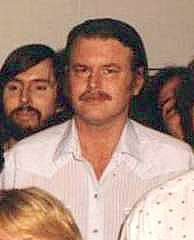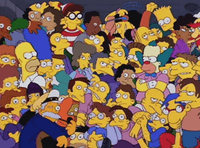Bart's Comet
"Bart's Comet" is the fourteenth episode of The Simpsons' sixth season. It originally aired on the Fox network in the United States on February 5, 1995.[1] In the episode, Bart Simpson accidentally discovers a comet, which is heading towards Springfield. The show's writing staff saw an issue of Time magazine which presented the threat of comets hitting Earth on its cover, and decided to create an episode in a similar vein. John Swartzwelder wrote the script, while Bob Anderson directed. "Bart's Comet" contains references to Where's Waldo? and The Twilight Zone, and received positive commendations from reviewers.
Plot
After Bart sabotages Principal Skinner's weather balloon, Skinner decides to punish him by having him help with his amateur astronomy. Bart accidentally locates a comet, and scientists soon discover that it is heading straight for Springfield. Professor Frink plans to launch a missile at the comet, dispelling everyone's fears. However, the missile flies past the comet and destroys the only bridge out of town.
Homer decides that his family should stay in the bomb shelter that Ned Flanders built, and soon, the rest of the townspeople arrive. Homer is unable to close the door so Ned is kicked out. Eventually, Homer feels guilty and leaves as well, followed by the other townspeople and they all converge on a hill with Ned to await death. As the comet enters the atmosphere, it burns up in the thick layer of pollution over Springfield, leaving the town safe.
Production

The episode was written by John Swartzwelder and directed by Bob Anderson. After seeing an issue of Time magazine, which presented the threat of comets hitting Earth on its cover, the writing staff decided to have an episode based on the concept of a comet hitting Springfield. They fleshed out the episode's plot over several days and Swartzwelder then set about writing the details of the script.[3] According to showrunner David Mirkin, examples of "Swartzwelder humor" in the episode include the American fighter pilots mistaking Groundskeeper Willie for an Iraqi jet and cutting to Grampa and Jasper outside a 1940s General store.[3] For the bomb shelter scene, the mass of townspeople was constructed on multiple layers so that it was easier to animate.[4]
Kent Brockman's list of gay people is composed of the show's production staff, who had to sign legal agreements that they would not sue their own show. As a result, according to show creator Matt Groening, many of the staff appear on lists of gay people on the Internet.[3][5] The episode marks the first appearance of Database, a character Groening dislikes if he is used for anything more than one line.[5]
Mirkin considers the episode to be one of his all time favorites, calling it a "perfect Simpsons episode" due to the size of the plot, emotion and observational humor.[3]
Cultural references
The couch gag is a reference to the animation of Fleischer Studios.[3] The constellation of the Three Wise Men is a drawing of the The Three Stooges.[3] The townspeople yanking their collars after the rocket destroys the only bridge out of town is a reference to Charles Nelson Reilly's performance in The Ghost & Mrs. Muir.[3] Waldo from Where's Waldo? appears near the top-left of a frame during the first group shot in the bomb shelter, imitating the style of the Where's Waldo? books.[3] The bomb shelter scenes were based on The Twilight Zone episodes "The Shelter" and "The Monsters Are Due on Maple Street".[3] The episode makes references to Back to the Future, including when Professor Frink accidentally sets his town model on fire, just like Doc Brown.[2] The Super Friends are named after the 1970s cartoon of the same name and as the comet approaches Springfield, the townspeople sing "Que Sera Sera", a song originally recorded by Doris Day for Alfred Hitchcock's 1956 film The Man Who Knew Too Much.[2][3]
Reception
In its original broadcast, "Bart's Comet" finished joint 33rd (with The X-Files and Hangin' with Mr. Cooper) in the ratings for the week of January 3 to February 5, 1995, with a Nielsen rating of 11.3. It was the fourth highest rated show on the Fox network that week.[6][7]
Warren Martyn and Adrian Wood, the authors of the book I Can't Believe It's a Bigger and Better Updated Unofficial Simpsons Guide, called it an "excellent episode" and praised the "great moment when the ever-pious Maude Flanders happily sacrifices her Neddy".[2] Mikey Cahill of the Herald Sun picked the episode's chalkboard gag, "Cursive writing does not mean what I think it does", as one of his favorite chalkboard gags in the history of the show.[8] Colin Jacobson of DVD Movie Guide said in a review of the sixth season DVD that he did not "share the same level of enthusiasm for it" as Mirkin, concluding: "I think it provides a consistently strong show. It stretches reality a bit, but that’s not a problem–or unusual for the series–and the program ends up as a positive one."[9] Ryan Keefer of DVD Verdict gave the episode a B-.[10] TV critics Matt Zoller Seitz and Alan Sepinwall cited the episode as how The Simpsons "always had the culture and the species on its mind even when it was clowning around", pointing to the moment near the end of the episode when the camera slowly pans across the Springfieldians' faces in the bomb shelter while Ned Flanders sings "Que Sera Sera": "a moment of existential terror that gives way to graceful resignation."[11] In the July 26, 2007 issue of Nature, the scientific journal's editorial staff listed "Bart's Comet" among "The Top Ten science moments in The Simpsons".[12]
References
- 1 2 Groening, Matt (1997). Richmond, Ray; Coffman, Antonia, eds. The Simpsons: A Complete Guide to Our Favorite Family (1st ed.). New York: HarperPerennial. p. 165. ISBN 978-0-06-095252-5. LCCN 98141857. OCLC 37796735. OL 433519M..
- 1 2 3 4 Martyn, Warren; Wood, Adrian (2000). "Bart's Comet". BBC. Retrieved 2008-03-27.
- 1 2 3 4 5 6 7 8 9 10 11 Mirkin, David (2005). DVD Commentary for "Bart's Comet", in The Simpsons: The Complete Sixth Season [DVD]. 20th Century Fox.
- ↑ Anderson, Bob (2005). DVD Commentary for "Bart's Comet", in The Simpsons: The Complete Sixth Season [DVD]. 20th Century Fox.
- 1 2 Groening, Matt (2005). DVD Commentary for "Bart's Comet", in The Simpsons: The Complete Sixth Season [DVD]. 20th Century Fox.
- ↑ "How They Rate". St. Petersburg Times. 1995-02-10. p. 15.
- ↑ Associated Press (1995-02-10). "Nielsen Ratings". The Tampa Tribune. p. 6.
- ↑ Cahill, Mikey (2007-07-26). "Fab Five". Herald Sun.
- ↑ Jacobson, Colin (2003). "The Simpsons: The Complete Sixth Season (1994)". DVD Movie Guide. Archived from the original on 25 December 2008. Retrieved 2008-12-18.
- ↑ Keefer, Ryan (2005-08-29). "DVD Verdict Review - The Simpsons: The Complete Sixth Season". DVD Verdict. Archived from the original on 25 December 2008. Retrieved 2008-12-18.
- ↑ Seitz, Matt Zoller; Sepinwall, Alan (6 September 2016). "Why The Simpsons Is the Best TV Show Ever". Vulture. New York Media, LLC. Retrieved 15 October 2016.
- ↑ Hopkin, Michael (2007-07-26). "Science in comedy: Mmm... pi". Nature. 448 (7152): 404–405. doi:10.1038/448404a. Retrieved 2011-11-05.
External links
| Wikiquote has quotations related to: "Bart's Comet" |
- "Bart's Comet" at The Simpsons.com
- "Bart's Comet episode capsule". The Simpsons Archive.
- "Bart's Comet" at TV.com
- "Bart's Comet" at the Internet Movie Database
